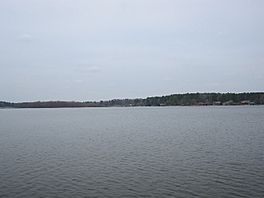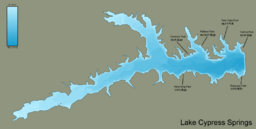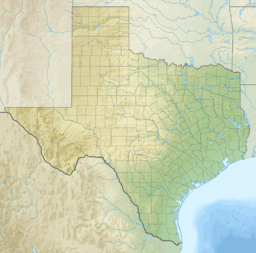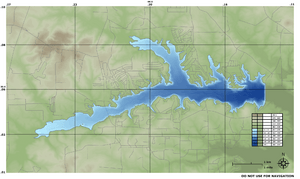Lake Cypress Springs facts for kids
Quick facts for kids Lake Cypress Springs |
|
|---|---|

Lake Cypress Springs looking north on the north branch.
|
|

Map showing the depth of different areas of the lake and the public parks on the lake.
|
|
| Location | Franklin county, Texas, US |
| Coordinates | 33°03′38″N 95°10′58″W / 33.06056°N 95.18278°W |
| Type | Reservoir |
| Primary inflows | Big Cypress Creek |
| Primary outflows | Lake Bob Sandlin |
| Basin countries | United States |
| Managing agency | Franklin County Water District |
| Construction engineer | Wisenbaker, Fix, and Associates |
| First flooded | 1970-07-07 |
| Surface area | 3,461 acres (1,401 ha) |
| Average depth | 19.29 ft (5.88 m) |
| Max. depth | 56 ft (17 m) |
| Water volume | 66,756 acre⋅ft (82,342,000 m3) |
| Shore length1 | 47 mi (76 km) |
| Surface elevation | 378 ft (115 m) |
| Islands | 1 |
| 1 Shore length is not a well-defined measure. | |
Lake Cypress Springs is a large lake in Northeast Texas. It covers about 3,461-acre (1,401 ha) of land. This lake is located about 90 miles (140 km) east of Dallas, Texas.
People use Lake Cypress Springs for many things. It's a popular spot for fun activities like boating and swimming. It also provides water for towns and businesses. A special lake patrol keeps everyone safe. They make sure boats follow rules and that people have fishing licenses. The lake is home to many houses, with about 850 homes right on the water. In 2011, a magazine called D Magazine named Lake Cypress Springs one of the "10 Best Lakes to Call Home."
Contents
Building Lake Cypress Springs
The idea to build Lake Cypress Springs started on 10 November 1966. The goal was to create a lake that could hold a lot of water. The Vibig Construction Company from Dallas, Texas, began building the dam in 1 July 1968. They finished the dam on 15 February 1971.
The dam is very long, about 5,230 ft (1,590 m). Its top sits 395 ft (120 m) above sea level. Water leaves the lake through a special "morning-glory-type spillway." This spillway is like a giant drain that helps control the water level. It also has a 6-foot (1.8 m) fish screen to protect fish. There's also an emergency spillway to help during big floods. Building the dam cost about US$1.34 million in 1969.
How the Lake Was Formed
When the dam was being built, the lake was first called Big Cypress Creek Lake. Later, it was known as Lake Franklin County. Finally, on 2 April 1971, its name was officially changed to Lake Cypress Springs.
The area where the lake now sits used to be covered with trees and plants. Workers had to clear all this woody land. This was important to make the lake good for fun activities like boating. If they hadn't cleared it, the lake would have been too shallow and full of obstacles. Some roads, like FM 115, even had to be moved to make way for the new lake.
In 2014, a large oil pipeline called the Keystone Pipeline was built near the lake. On 27 December 2015, very heavy rains caused the lake to rise to its highest level ever. During this time, no boats were allowed on the lake for safety. The lake handled a huge amount of water, moving about 786,000,000 US gal (2.98×109 L; 654,000,000 imp gal) in just one day to prevent flooding.
Every year, around the 4th of July, there's a big fireworks show at Mary King Park. In 2009, about 20,000 people watched the show, many from their boats on the lake!
Lake Environment
Scientists have studied the bottom of Lake Cypress Springs. They found that the lake bed is mostly made of sand and clay. The deepest mud is in the old path of the Big Cypress Creek, reaching about 7.2 ft (2.2 m) deep.
Parks Around the Lake
Lake Cypress Springs has six parks for people to enjoy: Walleye Park, Twin Oaks Park, Guthrie Park, Overlook Park, Dogwood Park, and Mary King Park. You can go camping at some of these parks, either in tents or RVs. The Franklin County Water District takes care of these parks. Camping prices vary depending on the season and park. The closest state park is Lake Bob Sandlin State Park, which is about 4 mi (6.4 km) away.
Plants in and Around the Lake
Lake Cypress Springs is special because it doesn't have much of an invasive plant called hydrilla. This is thanks to special fish called Triploid Grass Carp that were put into the lake in 1997 and 2006. These fish eat the hydrilla, keeping the lake clear for swimming and other fun activities.
You can find American lotus flowers at the west end of the lake where the water is shallow. The lake is mostly surrounded by loblolly pines, which grow well in East Texas. Since 2003, there's been a project to help the lake's natural plants grow better, including protecting the beautiful cypress trees.
Birds of the Lake
Many different kinds of birds live around Lake Cypress Springs. You might see cattle egrets, American avocets, American herring gulls, and Red-headed woodpeckers. There are also Osprey, Northern flickers, and Buff-bellied pipits.
The lake is home to many Wood ducks, Black-bellied whistling ducks, great egrets, and Great blue herons. Even in winter, you can spot American white pelicans and bald eagles flying around.
Fish in the Lake
The lake has been stocked with many fish over the years. This helps attract anglers (people who fish) to the lake. You need a Texas fishing license to fish here.
| Fish Type | How Many You Can Keep | Smallest Size You Can Keep | Notes |
|---|---|---|---|
| Channel and Blue catfish | 25 | 12 in (300 mm) | You can mix these two types. |
| Flathead catfish | 5 | 18 in (460 mm) | |
| White bass | 25 | 10 in (250 mm) | |
| Largemouth bass | 5 | 14 in (360 mm) | This limit includes both largemouth and spotted bass. |
| Spotted bass | 5 | NA | This limit includes both largemouth and spotted bass. |
| White crappie and Black crappie | 25 | 10 in (250 mm) | You can mix these two types. |
| Species | Year | Number of Fish | Size When Stocked |
|---|---|---|---|
| Blue catfish | 1982 | 6,154 | Advanced Fingerling (young fish) |
| Channel catfish | 1993 | 4,991 | Advanced Fingerling |
| Redear sunfish | 1967 | 2,750 | Unknown |
| Bluegill and Green sunfish | 1997 | 500 | Fingerling |
| Largemouth bass | 2015 | 70,570 | Fingerling |
| Black crappie | 1966 | 2,750 | Fingerling |
| Walleye | 1972 | 53,460 | Fry (very young fish) |
| Triploid grass carp | 2006 | 3,000 | Adult |
 |
Jim Chapman Lake 34 mi (55 km) | Hugo Lake 70 mi (110 km) | Lake Monticello 7 mi (11 km) |  |
| Lake Fork Reservoir 27 mi (43 km) | Lake Bob Sandlin 6 mi (9.7 km) | |||
| Lake Palestine 63 mi (101 km) | Lake Livingston 160 mi (260 km) | Lake O' the Pines 37 mi (60 km) |
- 1.Up to date as of 2015.




